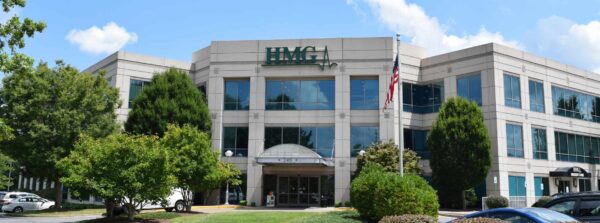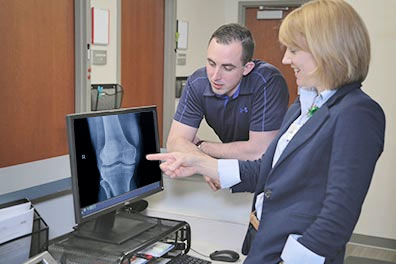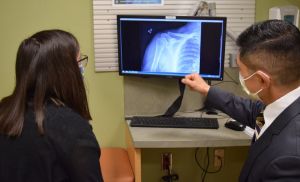Immediate Orthopedic Treatment
HMG Orthopedic Walk-in Clinic offers immediate treatment for musculoskeletal injuries and chronic conditions. We understand that sprains, strains and fractures can happen anytime. When you’re in pain, you need expert care quickly. So, our orthopedic specialists are here for you from beginning to end. Unlike traditional urgent cares and emergency rooms, there’s no need for referrals to a specialist. Simply walk through our door to get affordable treatment without needless waiting.
Our Locations
- Walk-Ins Welcome

Kingsport
HMG Orthopedics & Sports Medicine at Medical Plaza
Get DirectionsGo to this location
105 W. Stone Drive
Suite 4B
Kingsport, TN 37660 - Walk-Ins Welcome

Bristol
HMG Orthopedics & Sports Medicine at Sapling Grove
Get DirectionsGo to this location
240 Medical Park Blvd.
Suite 1500
Bristol, TN 37620
Benefits of Orthopedic Walk-In Clinics
Our orthopedic clinics offer excellent treatment options for acute injuries and chronic pain. With access to a full range of diagnostic equipment, HMG specialists assess your orthopedic pain quickly. Then, our team customizes a treatment plan to get you back in the game. Below are some of the many benefits of our orthopedic walk-in clinics.
-
Orthopedic Specialists
Our on-site healthcare professionals can provide immediate treatment for sprains, strains and breaks. We also have therapists, surgeons and other providers for follow up services that orthopedic conditions often require.
- Diagnostics
We understand that successful treatment begins with an accurate diagnosis. That’s why our walk-in clinics have a complete diagnostic center, including MRI, CT, x-rays and more. Our advanced technology helps us pinpoint your orthopedic problem.
- Less Expensive
Crowded emergency rooms are for life-threatening situations, so care is expensive. Our walk-in clinics use the same diagnostic equipment and provide specialized orthopedic treatment at a fraction of the cost.
- DME (Durable medical equipment)
Many orthopedic conditions require equipment (boots, braces, splints, crutches, etc.) following treatment. Because we do casting, bracing and splinting on-site, we can determine the best DME for you.
- Save Time
Avoid long waits and lengthy referrals. Our clinics offer immediate access to an orthopedic specialist. No appointment needed.
Our Orthopedic Services
Orthopedic pain can result from injury or overuse of your bones, joints and other connective tissue in the musculoskeletal system. Bone and joint injuries due to accidents are easy to diagnose. But, it’s not so easy to pinpoint the cause of pain related to strains, pulls and overuse. Overlapping symptoms make self-diagnosis even more challenging. Our specialists have a complete diagnostic center to assess and develop a treatment plan for your orthopedic pain. Listed below are some of the more common conditions we treat.
-
Arm/Elbow
Our arms are in constant motion, so it is no surprise that arm/elbow pain is a very common condition. Even minor arm/elbow pain can limit your daily activities. If you are experiencing these symptoms, see an orthopedic specialist at one of our walk-in clinics.
- Dislocation of the elbow can occur when your outstretched arm takes a direct hit. Symptoms include a visibly odd angle at the elbow and extreme pain.
- Fracture of the arm usually is due to an accident. Symptoms include pain, swelling, weakness and/or change in shape.
- Tendonitis is inflammation of the tendons in your arm. Overuse, repetitive motion and sports activities are common causes. Pain, burning and weakness are typical symptoms.
- Ankle/Foot
Our feet take a pounding every day. So, ankle/foot injuries and conditions are especially common for active people. But, we’re all at risk for many of the conditions listed below. We also have podiatrists on staff if your diagnosis requires that medical specialty.
- Sprains usually occur when you roll or turn your foot or ankle, which pulls or tears the ligaments. Ligament damage can range from mild to severe. Pain, swelling and bruising are common symptoms.
- Fractures are due to trauma. Depending on which bone is broken, symptoms may include pain (more severe when you put weight on it), swelling, bruising, tenderness to touch, and/or distorted shape.
- Strains happen when you stretch or tear a muscle or tendon. Symptoms are similar to sprain, but also include muscle spasms and cramping.
- Knee/Leg
Limping around your daily activities with knee or leg pain takes a toll on your life. Continued use may worsen your condition. If knee or leg pain bothers you more than a day or two, it is important to get it checked by an orthopedic specialist.
- Fractures related to accidents are more common in the lower leg and knee area. Car accidents are the leading cause of broken femurs. Symptoms include severe pain, swelling, inability to bear weight, numbness and deformed shape.
- Torn ligaments are a very common knee injury because it is so easy to do. Simply changing directions quickly can result in a ligament tear. Symptoms include pain, swelling and lack of stability.
- Meniscus tears often result from twisting your knee. Pain, swelling and limited range of motion are among the common symptoms.
- Hamstring injuries often occur when sprinting in sports or running. An injury can be a torn, pulled or stained muscle. If you feel a sudden sharp pain in the back of your thigh, watch for swelling and bruising to follow within a few hours.
- Achilles tendonitis & ruptures are common, especially with overuse in running. The Achilles tendon runs along the back of your heel to connect your calf and heel. Seek care from an orthopedic specialist if you have pain, stiffness or swelling of your Achilles tendon.
- Hand/Wrist
Repetitive motion and injury are the primary causes of most hand and wrist pain. Overused muscles and cramped nerves in our hands and wrists are more common than ever, thanks to smartphones, gaming and computer-focused work environment. Appropriate treatment puts you back in motion again.
- Fractures can occur in any of your hand and wrist bones. Symptoms include swelling, odd angle or deformed shape, inability to move a finger or limited wrist motion.
- Dislocations can occur in any knuckle in finger injuries. Signs that you have a dislocation include swollen or crooked finger, pain and weakness in affected finger.
- Tendonitis is usually the result of overuse. Swelling of tendons causes inflammation and affects movement in your fingers, thumb or wrist. Swelling, pain in forearm and wrist as well as difficulty moving the affected hand and wrist are indications of tendonitis.
- Carpal tunnel syndrome is the result of pressure on the wrist nerves. Symptoms include numbness, pain and feeling of electric shock in hands or fingers.
- Shoulder
Discomfort and pain in your shoulder area can be the joint. Or, your pain may come from muscles, tendons and ligaments surrounding the shoulder joint. Injuries and overuse are the reasons of shoulder pain. In addition, we become more susceptible to shoulder injuries as we age. If you are feeling pain, don’t push through it more than a day or two. Treatment can help you get back to the daily routine that you enjoy.
- Rotator cuff tears are torn tendons. This painful condition can be caused by lifting a heavy object or by repetitive motion. Symptoms include pain and/or weakness when raising your arm.
- Dislocated or separated shoulder happens when there is a disconnection or misalignment in the shoulder joints and surrounding bones. Indicators may include pain and/or inability to move your arm.
- Fractures typically involve the bones connected to the shoulder joint (upper arm bone, collarbone and shoulder blade). Most fractures result from a fall or hard hit to the shoulder area. Pain, limited range of motion and swelling are signs that of a fracture.
- Tendonitis in the shoulder typically is in the bicep muscle and elbow. A bulge in the bicep area, cramping, weakness and pain are symptoms of tendonitis.
- Hip
Pain in your hip can vary from mild to severe. While trauma such as a fall can break a hip, overuse and ligament tears are more common. If you have pain in your hip area, stop by an HMB Orthopedic Walk-In Clinic for a diagnosis.
- Fractures typically are caused by a fall. However, underlying diseases that weaken bones can make you more susceptible to broken bones. Symptoms include pain and loss of mobility in your hip.
- Ligament tears occur when you overstretch or twist your hip joint. Bruising, pain with limited mobility, swelling and weakness are signs of a tear.
- Back/Neck
Your spine, back, and neck consist of a complex group of muscles, nerves and discs and joints. You can have constant pain if one small area is off. Or, you may experience pain only when you move because that is when a nerve is pressed. Genetics, disease, overuse, injuries and more can play a role in back and neck pain.
If you’re in pain, see one of HMG’s orthopedic specialists for a complete evaluation. We can personalize a treatment plan for you to help you return to pain-free living.
Partnering in Sports Medicine
Sports medicine goes beyond sports. It’s more than supporting professional and school athletes. Our sports medicine providers recognize that athletes come in all shapes and sizes. Don’t let the term “sports medicine” fool you. We specialize in injury treatment and prevention related to all types of exercise—not just for athletes. Whether you are a weekend warrior or mom going to the gym, you can count on us. We also support high school and semiprofessional athletics in our community. Below are some local teams working with our orthopedic professionals.
- Bristol State Liners
- King University
- Kingsport Axmen
- Milligan University
- Unicoi High School
- Virginia High School
- Diagnostics





